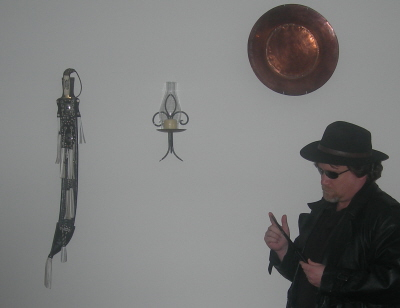|
About This Author
Come closer.
|
Complex Numbers
Complex Numbers
A complex number is expressed in the standard form a + bi, where a and b are real numbers and i is defined by i^2 = -1 (that is, i is the square root of -1). For example, 3 + 2i is a complex number.
The bi term is often referred to as an imaginary number (though this may be misleading, as it is no more "imaginary" than the symbolic abstractions we know as the "real" numbers). Thus, every complex number has a real part, a, and an imaginary part, bi.
Complex numbers are often represented on a graph known as the "complex plane," where the horizontal axis represents the infinity of real numbers, and the vertical axis represents the infinity of imaginary numbers. Thus, each complex number has a unique representation on the complex plane: some closer to real; others, more imaginary. If a = b, the number is equal parts real and imaginary.
Very simple transformations applied to numbers in the complex plane can lead to fractal structures of enormous intricacy and astonishing beauty.
October 18, 2023 at 10:23am October 18, 2023 at 10:23am
| |
Mostly, I just think this is cool, so I'm sharing it. (From BBC)
What did Stonehenge sound like? 
New research into the prehistoric site's acoustical properties is revealing that the stone circle may have been used for exclusive ceremonies.
While fascinating, I'll note that there's still a lot of educated speculation in here.
Through the doors of a university building, down a concrete hallway and inside a foam-covered room stands a shin-high replica of one of the most mysterious monuments ever built: Stonehenge.
Shin-high replica of Stonehenge? Did they borrow it from This Is Spinal Tap?
"We know that the acoustics of places influence how you use them, so understanding the sound of a prehistoric site is an important part of the archaeology," said Trevor Cox, professor and acoustics researcher at the University of Salford in Manchester.
As long as the theory is sound.
(You're goddamn right pun intended, and I'm WAY more proud of that one than I have any right to be.)
Despite being the world's best-known and most architecturally sophisticated ancient stone circle, archaeologists still don't know who built Stonehenge or what it was used for.
We know who built it: People. That's right; not aliens. Probably.
Thanks to Cox's recent studies, however, we now know a fascinating detail about one of the world's most enigmatic sites: it once acted as a giant echo chamber, amplifying sounds made inside the circle to those standing within, but shielding noise from those standing outside the circle.
Which is cool and all, but did the ancient builders do that on purpose? If so, how, without a scientific theory of sound, did they know? Well, it's very likely that Stonehenge didn't spring suddenly out of nowhere; I'd bet money that earlier henges were made out of material slightly easier to obtain, transport, and build with, such as wood. So, I'd guess (but it's only a guess) trial and error.
Unless, of course, it was aliens.
Once the stones were painted grey and arranged in the correct distribution according to the computer model, the challenges of the testing process began.
Another thing I wonder is: why gray? (Look, they use British spelling and I use US spelling.) Does color somehow influence the acoustic properties? I'd have guessed it would be more about material and texture than color, which just goes to show that my guesses are just guesses.
Through mathematical processing, Cox was able to create a computer model that simulates the acoustic properties of Stonehenge and can distort voices or music to give a sense of what they would sound like within the circle. The results surprised him: although Stonehenge has no roof or floor, sound bounces between the gaps in the stones and lingers within the space. In acoustics, lingering sound is known as reverberation.
Which musicians use to great effect, mostly electronically these days.
These results showed that Stonehenge would have allowed people inside the circle to hear each other quite well, while those outside would have been excluded from any ceremonies taking place. Cox's research adds to a growing body of evidence that Stonehenge may have been used for rituals reserved for a select few, with one study even pointing to the possibility of a hedge grown to shield the view from those not participating.
While this is sensible knowing what humans can be like (sometimes elitist), I wonder if the people excluded, if this speculation is true, were also the people who did the hard manual labor of cutting, moving, and erecting the stones. That, too, would be typical human behavior. Thus, probably not aliens.
Cox acknowledges that unanswered questions about the real Stonehenge make it difficult for him to draw definitive conclusions from his work with the scale model.
Like I said above: educated speculation.
But, in short, apparently people living in England have been rocking out for a lot longer than we thought. |
© Copyright 2025 Robert Waltz (UN: cathartes02 at Writing.Com). All rights reserved.
Robert Waltz has granted InkSpot.Com, its affiliates and its syndicates non-exclusive rights to display this work.
|

